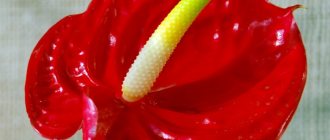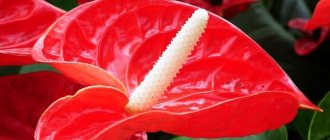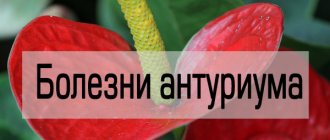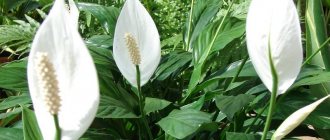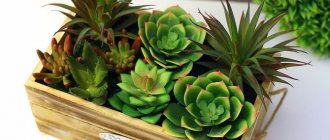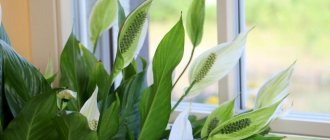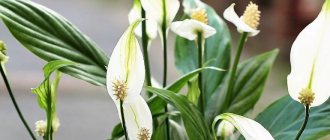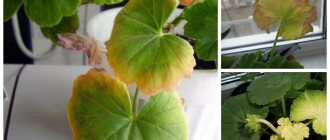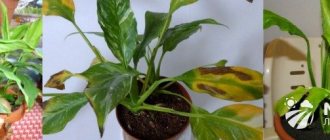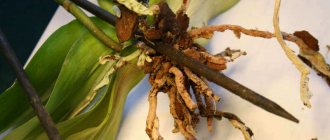Excess or lack of light
It is advisable to keep anthurium in partial shade - direct sunlight can cause burns on the leaves.
But it is also not recommended to place it in a too dark place - due to lack of lighting, the anthurium grows poorly and may not bloom. The leaves begin to turn pale from lack of light.
When there is an excess of light, anthurium leaves begin to turn yellow or may become bronze in color. You can also observe the appearance of brown spots on the tips of the leaves.
Excessive dry air
If the air in the room is very dry, the leaves of the anthurium also become dry. As a rule, this happens at the beginning of the heating season - after all, the plant has not yet had time to adapt to the changed conditions. If the air is too dry, yellowness first appears at the edges of the leaf and gradually moves towards the center. After this, the tips and edges of the leaves begin to dry. Dry air also leads to deformation of young leaves - they simply cannot unfold normally.
What to do: Provide the plant with the required humidity level of 70-85% using a household humidifier, or by placing containers of water next to the pot. A tray with expanded clay filled with water helps a lot. It is important that the roots do not have direct contact with the water in the pan, otherwise they will begin to rot.
Improper watering
If brown spots, dry areas and yellowness appear on the leaves of an anthurium, the problem is most likely due to improper watering of the plant. Both lack and excess of moisture have a negative effect on the flower. Excess moisture leads not only to yellowing of the foliage, but also to rotting of the roots, the appearance of mold and fungal diseases.
You also need to take into account that if there was water on the anthurium leaves (it got in after watering, etc.), this can cause brown spots to appear - the sun, through drops of water, like through a lens, burns the leaves.
With prolonged exposure to water, necrosis may develop on the leaves - it spreads along the leaf plate, starting from the edges, and gradually spreads throughout the entire leaf.
What to do: if the problem is too much moisture, try to completely dry the soil in the pot. You can even completely replace the entire soil. If you replant the plant, check all the roots for rot (it must be carefully cut off).
How and when to replant anthurium: videos and tips
Men's happiness after purchase in the store is transplanted after two weeks, not earlier. If the plant has flowers, you can wait for it to bloom or replant during flowering using the transshipment method.
Adult specimens, which have been growing at home for many years, are replanted once every three or four years. Small leaves, scanty flowering and roots that no longer fit into the pot indicate that it is time to start replanting. It is better to replant in spring or autumn.
The rules for transplanting anthurium during and after flowering are the same:
- The new pot should be 3-4 cm wider and higher than the old one. If you choose a very large pot, a man’s happiness will not grow and bloom for a long time, since he must first grow roots according to the volume of the new container.
- The soil for replanting must be nutritious. In specialized stores you can easily find a special soil mixture for anthurium.
- Drainage must be poured into the bottom of the pot, otherwise water may stagnate in the ground.
- Place a layer of 3-4 cm of substrate on the drainage.
- Carefully remove the flower along with a lump of earth and place it in a new pot.
- Fill the voids between the pot and the roots with soil. Shake the container with the plant and sprinkle some soil on top.
- Pour water at room temperature. Add soil on top, as the soil will settle a little after watering.
For the first three days to adapt, keep Men's Happiness in the shade.
You will be interested to know: Caring for a cyclamen flower when it blooms and during the dormant period
About transplanting an anthurium flower, watch a video clip from the YouTube channel.
Fungal disease on anthurium
If the room is cool and watering is poor, there is a high risk of fungal disease. When fungi begin to work, dry spots appear on the leaves. First, small yellow spots of irregular or round shape appear, then they begin to expand, and the center becomes brown and begins to dry.
The damaged areas may begin to crumble and dark circles may form around the area. But when fungi attack, not only the foliage suffers - the roots begin to rot. Therefore, you must definitely pull out the plant and check its roots, cutting off all rotten areas. Healthy roots should be light cream or white in color. If they turn brown or black, soft spots appear, possibly with areas of mucus - this is rot.
After cutting off the rotten roots, the cut sites are treated with crushed coal, and the anthurium itself is treated with a fungicide. In this case, before processing, you need to remove all leaves damaged by the fungus.
The pot needs to be disinfected and filled with fresh substrate.
How to save a green friend if the roots have rotted?
Root rotting occurs from excessive watering and manifests itself as darkening of the neck. In order to save the plant, you need to transplant it into a new container and fresh soil, removing all damaged roots.- Root rot occurs due to the action of fungi on the root system . The roots first turn red, then turn black, and then die. Symptoms include drying leaves and wilting flower stalks. Treatment consists of transplantation with removal of the affected areas of the root system.
Lack of nutrition or excess of it
If the anthurium begins to grow slowly, the young foliage becomes smaller, it is worth thinking about the proper nutrition of the plant. For example, with a lack of phosphorus, potassium and nitrogen, the foliage becomes brown. Lack of magnesium and calcium also affects the body in the same way. You can feed the plant with ready-made liquid fertilizer - it is better to do this weekly so that the anthurium can recover. At the same time, for fertilizing, use ¼ of the fertilizer recommended by the manufacturer. When the anthurium gains strength, you need to switch to feeding once every two weeks.
Excess nutrition can also harm the plant. In this case, it is recommended to completely change the soil in the pot. If there is an excess of nutrition, young leaves grow too large and pale, and can take on different colors.
Rot of the stem and root system
In this case, the plant begins to quickly wither; dark depressed spots appear on the basal part of the stem and on the surface of the roots, which are covered with a dense white coating. It's a fungus. Such mold may begin to appear on the leaves. Important: the disease is contagious and can spread to other plants.
What to do: remove from the pot, remove all areas affected by rot, treat the roots with a solution of potassium permanganate and a fungicide (phytocide, phytodoctor), completely replace the soil in the pot, having previously disinfected the pot itself.
Flower diseases male happiness
The disease is non-infectious and is caused by errors in care. The decorative surface of the leaf is covered with convex plaques, swellings and marsh-colored rings. Smallpox is provoked by cold indoor air, especially against a background of high humidity; any root damage or nutritional deficiencies.
Enatsii
Presumably the disease occurs due to sudden changes in temperature and humidity. There is a loss of decorativeness of the leaves; they become deformed, develop unevenly and become covered with convex growths of a rounded shape.
Stem rot
A fungal disease that appears when there is high humidity in both the surrounding air and the soil. Externally it is manifested by the formation of dark watery marks on the shoots and the death of stems. A characteristic sign is small sporangia in the affected areas; at the initial stage they are white, then darken.
The plant is quarantined, the affected parts are cut off and treated with fungicides, for example, Rovral, Fitosporin, copper sulfate. If treatment does not help, the flamingos are disposed of.
Table - to help diagnose the disease
| Causes | Symptoms |
| Dry air |
|
| Bright light/direct sunlight |
|
| Lack of light |
|
| Watering with hard water, excess calcium |
|
| Watering with cold water |
|
| Waterlogging of the soil, overwatering |
|
| Lack of nutrition |
|
| Excess nutrition |
|
| Watering with chlorinated water |
|
| Hypothermia |
|
| Improper care |
|
Pests and diseases | |
| Anthracnose and septoria | Round or oval red-brown, yellow spots from 1.5 to 13 millimeters, often a black dot (spores) can be seen inside. The stain spreads across the leaf and forms holes. |
| Fusarium wilt | Massive, rapid withering of leaves and unnatural bending of peduncles and petioles, dark vessels are visible on the cut of leaves, roots rot. |
| Root rot | The leaves lose their shine, become lighter, and then turn black. Upon examination, the roots are rotten and frayed, the root sheath is separated from the core. |
| Powdery mildew | The leaves curl, turn yellow, become smaller, and a white coating appears on the underside of the leaf. |
| Rust | Red-brown spots on the bottom of the leaf and at the same time light spots on the top, death of the affected leaves. |
| Aphid | The leaves curl, turn yellow, and become covered with a sticky coating. Small green sucking insects are visible inside the leaves and on young shoots. |
| Trips | Affected leaves have an uneven yellow-green color, and the inside of the leaf is covered with black insect excrement. The leaves dry out and fall off. |
| Shchitovka | Whitish or golden tubercles on the leaves. |
| Spider mite | The leaf becomes covered with yellow specks, curls, and dries out. When finely sprayed, a web with insects is visible. |
| Mealybug | The affected parts of the plant seem to be dusted with flour |
You might be interested:
- Dieffenbachia leaves turn yellow
Dieffenbachia is a plant about which you can hear many different opinions. Some say that it is very... - Cucumber leaves turn yellow One of the problems when growing cucumbers is yellowing of the leaves. If measures are not taken in a timely manner, then...
- Why do monstera leaves turn yellow and fall off? Monstera is an unusual plant. Probably every owner of this marvelous vine has noticed that in cloudy weather...
Leaf diseases
Why do Anthurium leaves turn yellow? What to do?
May occur during natural aging. In this case, the color of one or two lower leaves changes. These gradually dry out and fall off. To improve its appearance, it is recommended to rejuvenate the anthurium.
If the plant is young and the leaves are already turning straw-colored, it is quite possible that the flower is receiving too much light. To fix the problem, just move the pot to a less lit place.
The color becomes pale with a yellowish tint even with a lack of sun, if the flamingo stands far from the window. You can equip the place with additional lighting or simply move the flower to the windowsill of the western or eastern window.
Drying
The flamingo stands in a draft, is kept in constant coolness, and lacks moisture in the soil or external environment.
Appearance of spots
- Large spilled brown spots indicate frostbite.
- Beige dry specks are evidence of the activity of the sun's rays, which caused burns. Shading or changing the location will save the plant from further damage.
- Spots of different diameters covering any part of the leaf surface may indicate a pest invasion, especially when growth stops at the same time. If the new leaves become excessively large in size, and any marks form on the more mature ones, then we are talking about an excess of fertilizers in the soil.
Why do the tips of Anthurium leaves dry out?
The most obvious reason is that the air in the room is always dry, which causes the plant to suffer. You can increase the humidity by regular spraying and installing a tray filled with wet stones such as pebbles or expanded clay. Have you followed all the recommendations, but the edges are still drying out? This means that the roots of the delicate epiphyte do not receive oxygen. You should change the soil by adding loosening components such as pieces of brick, charcoal, pine and fir cones, and perlite.
The flower is drying
Usually this is a sign of physiological aging of the inflorescence; it dries up and forms a fruit. Also, the cause may be excessive dryness of the soil and air, excess light and sunburn.
The leaves of the flower turn black. Male happiness
This problem occurs when the calcium content in the soil is high. The soil must be changed to fresh, high-quality soil and the application of fertilizers must be reduced in the future.
Flowers turn black
Anthurium really doesn’t like this! Pick off any damaged flowers and remember the lesson so you don't repeat the same mistake again.
The leaves are curling
In this way, the tropical resident is protected from unfavorable environmental conditions, namely:
- drafts
- lack of light
- direct rays of the sun
- arid air.
Wilting foliage
Loss of turgor occurs due to rotting of the root system.
Urgent resuscitation of a sick flower is required. It is removed from the soil, the roots are washed in warm water to completely remove dirt and carefully inspected. All affected parts are cut off, and the remaining parts are dried in air for at least 30 minutes. During this time, the soil is completely replaced with fresh one, and the pot is disinfected in a strong solution of potassium permanganate.
